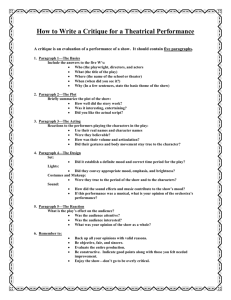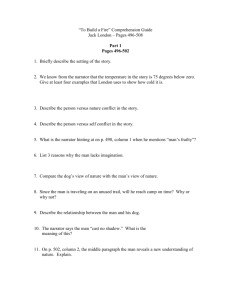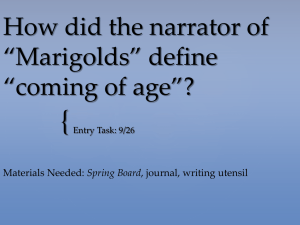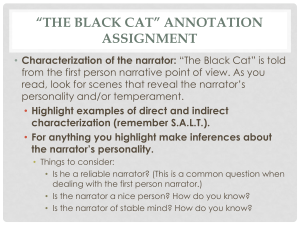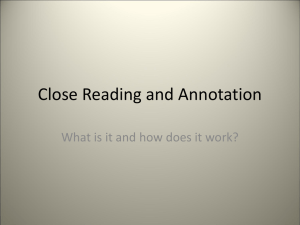Focus Lessons Answer Key Lesson 1: Elements of Fiction 1. A
advertisement
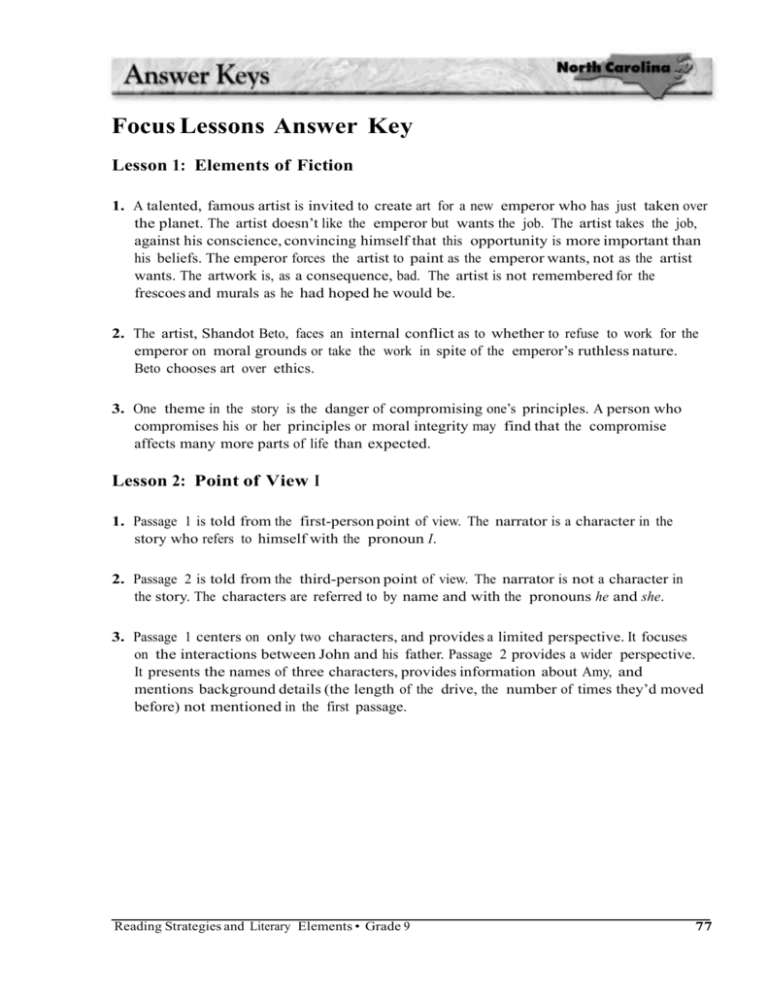
Focus Lessons Answer Key Lesson 1: Elements of Fiction 1. A talented, famous artist is invited to create art for a new emperor who has just taken over the planet. The artist doesn’t like the emperor but wants the job. The artist takes the job, against his conscience, convincing himself that this opportunity is more important than his beliefs. The emperor forces the artist to paint as the emperor wants, not as the artist wants. The artwork is, as a consequence, bad. The artist is not remembered for the frescoes and murals as he had hoped he would be. 2. The artist, Shandot Beto, faces an internal conflict as to whether to refuse to work for the emperor on moral grounds or take the work in spite of the emperor’s ruthless nature. Beto chooses art over ethics. 3. One theme in the story is the danger of compromising one’s principles. A person who compromises his or her principles or moral integrity may find that the compromise affects many more parts of life than expected. Lesson 2: Point of View I 1. Passage 1 is told from the first-person point of view. The narrator is a character in the story who refers to himself with the pronoun I. 2. Passage 2 is told from the third-person point of view. The narrator is not a character in the story. The characters are referred to by name and with the pronouns he and she. 3. Passage 1 centers on only two characters, and provides a limited perspective. It focuses on the interactions between John and his father. Passage 2 provides a wider perspective. It presents the names of three characters, provides information about Amy, and mentions background details (the length of the drive, the number of times they’d moved before) not mentioned in the first passage. Reading Strategies and Literary Elements • Grade 9 77 Lesson 3: Point of View II 1. In paragraph 2, the narrator comments on the action by revealing the reason for the children’s frustration. This is the first time that we are aware that the narrator is omniscient. This becomes increasingly clear when the narrator reveals the thoughts and feelings of more than one character: Amy’s in paragraph 1, Mr. Saclalos’s in paragraph 3, and John’s in paragraph 4. The final paragraph looks ahead to the future, another sign of omniscience. 2. The house disappoints Amy before she even sees it. She is tired of moving and doesn’t trust the possibility that this move may be permanent. John shares her feelings and is saddened by the toy left behind by the previous family. The plastic truck seems to remind him of what it’s like to have a happy, lasting home. Mr. Saclalos understands his children’s apprehension, but believes in the stability this new house promises. 3. In the last paragraph, the narrator foresees events that are not known to the characters themselves. The narrator reveals that soon the family will adjust to their new house. Soon, they will find the stability and the happiness that they all wanted. Lesson 4: Dialogue 2. Sophie’s mother is concerned about Sophie and glad that she has come. She grabs Sophie and spins her “like a top,” thanks the woman who brought Sophie, and asks many questions. She also lends Sophie her jacket, even though she herself is shivering. All these actions show love for Sophie and concern for her welfare. 3. Without the dialogue, this scene would be far less engaging. The dialogue dramatizes the scene. Readers can observe the dynamics between the two characters and draw their own conclusions. The fact that Sophie says nothing while her mother talks extensively indicates that the little girl is scared or perhaps nervous. 78 Reading Strategies and Literary Elements • Grade 9 Copyright © The McGraw-Hill Companies, Inc. 1. Sophie seems slightly dazed and frightened. The main clue we get to her emotional state is that she doesn’t speak to her mother. Also, in paragraph 7, when the woman who accompanied Sophie disappeared, Sophie thinks, “It was as though I had disappeared.” This suggests that Sophie is feeling lonely and abandoned. She does not yet feel comfortable with her mother. Lesson 5: Flashback 1. This flashback takes the reader away from the action for a little while. By inserting a flashback at a critical moment in the narrative, the writer prolongs the moment and therefore adds to the suspense. Also, the author uses the flashback to reveal a hidden side of Cornelia’s personality—her shyness. Knowledge of Cornelia’s shyness adds to the tension of the present moment. 2. We learn that Cornelia and Bonnie have been friends since the sixth grade, and that Bonnie encouraged Cornelia to overcome her shyness and fears and to have more fun. The author probably provided this flashback to lead up to Cornelia’s moment of insight at the end. Knowing that Cornelia previously viewed herself as less courageous than Bonnie, we recognize the significance of her sudden realization that she is brave, too. 3. The writer could simply describe Cornelia’s mixed feelings about Bonnie, without providing the details of how they met. A description would not be as effective as a flashback, because it would not provide a vivid example of Bonnie’s influence and Cornelia’s past behavior. The flashback allows the reader to see the development of Cornelia’s personality over a long period of time. Copyright © The McGraw-Hill Companies, Inc. Lesson 6: Foreshadowing 1. Yes, Kanela will probably make the team. The sun comes out from behind the clouds, a symbolic detail that, in movies and books, often foreshadows a positive event. The author also describes Kanela’s change of mood: “With the field brightening, Kanela felt a confident wave of calm rush over her.” These details suggest that Kanela will be successful. 2. Early on in the passage (paragraph 2), the author makes a comparison between the dreary weather and Kanela’s mood. Later on, in paragraph 6, the sun suddenly breaks through the clouds and the sky brightens. This shift in weather foreshadows Kanela’s ultimate success. 3. One common way authors foreshadow disaster is through descriptions of weather. Darkening skies, blood-red sunsets, and sudden storms all seem to indicate imminent disaster. Prophetic dreams and visions and minor acts of violence (for example, a cat killing a bird) also serve to foreshadow terrible events. Another common technique is to have a character say, “I have a bad feeling about this.” Sometimes characters have “hunches” that a disasterous event is going to happen. Reading Strategies and Literary Elements • Grade 9 79 Lesson 7: Irony 1. The tomb scene is an example of dramatic irony because we are aware that Juliet is not really dead, but Romeo does not have this knowledge and kills himself. 2. Dramatic irony adds suspense. When you know an action is pointless or futile, it becomes infused with drama. Also, dramatic irony gives viewers and readers a sense of superiority and distance. It allows us to look at the unfolding action from a distance, to recognize the characters’ errors, and to feel sympathy and compassion. 3. Answers will vary. Lesson 8: Style 1. Passage 1 is written in a sophisticated style. The sentences tend to be long, the vocabulary is difficult (“decomposed,” “detritus”), and there are frequent instances of figurative language (the dock is “like the last front tooth in a school-picture smile”; the boat is “like a desolate child wondering where its playmates had gone”). 2. Passage 2 is much simpler. The sentences are shorter and the vocabulary is easier. The passage contains minimal description and no figurative language. 3. Answers will vary. Copyright © The McGraw-Hill Companies, Inc. 80 Reading Strategies and Literary Elements • Grade 9 Lesson 9: Tone 1. The author is probably joking when he says such complimentary things about scorpions. While it is clear that he admires scorpions and finds them interesting, the terms are not meant to be taken literally. Instead, they provide a humorous way of describing the scorpions’ behavior. 2. The definition of impeccable is “without flaw.” The author uses this word humorously, since in the same sentence he mentions that the scorpions have the habit of eating each other. 3. The author has a dry, comical style. He uses high praise and poetic language to describe scorpions, but his words seem comical because they are so exaggerated. He describes such implausible scenes as the scorpions “waltzing slowly in circles among the moss cushions, claw in claw.” His purpose is probably to amuse the reader. Copyright © by The McGraw-Hill Companies, Inc. Lesson 10: Hyperbole 1. In paragraph 1, the author says that Joe lives in “a yellow house strategically placed for him to torture me,” which is obviously exaggeration. The author writes that when “Joseph walked down the street, trees quaked,” and that the “ground seemed to rumble under his feet.” The author’s description of Joseph’s hair as resembling “the bristles of a vacuum cleaner” is also probably hyperbolic; it is very unlikely that his hair could have actually looked like that. In paragraph 2, the author describes Joe’s stare as “leaden” and writes, “his eyes bored into the backs of our heads”—two phrases that clearly contain exaggeration. The description of his laugh as similar to the “guffawing of a hungry giant” is also hyperbolic. Joe is actually a little boy, but he seems huge to the young narrator. 2. Hyperbole is effective in a story about a bully because people often perceive bullies as being larger, meaner, and more threatening than they really are. The hyperbole allows the reader to see the bully as the narrator perceives him. This is very different from an objective, realistic description. 3. Answers will vary. Political speeches, poetry, editorials, and advertising also employ hyperbole to varying degrees. It may be useful to ask students to collect examples of hyperbole from television commercials or magazine advertisements. Reading Strategies and Literary Elements • Grade 9 81 Lesson 11: Archetype 1. There are actually three archetypal characters in this story. Cinderella is the archetypal heroine. She is beautiful and mistreated by her stepmother. The stepmother is the archetypal villain. She is the obstacle, and represents the injustice that the young heroine must face before she is saved by the prince. The prince is the archetypal hero. He provides her with the happiness she has longed for. 2. The events, characters, and ideas in this story are common to those in literature from many cultures. This archetype is that of a poor young woman who suffers injustice until a handsome, loving man rescues her. 3. Answers to this question will vary. Students may mention movies such as Pretty Woman, The Slipper and the Rose, and Ever After; the play My Fair Lady; and countless fairy tales, short stories, and novels that follow the same structure. Lesson 12: Allusion 1. There is an allusion to the biblical story of the Garden of Eden in line 6. 2. Frost is comparing changes in nature to the change that took place in the biblical story of the Garden of Eden. He is making the point that everything changes; just as the Garden of Eden fell from paradise to decay, all life must deteriorate and decay. 82 Reading Strategies and Literary Elements • Grade 9 Copyright © The McGraw-Hill Companies, Inc. 3. The point of this poem is to discuss the fleeting quality of everything in nature. The “gold” of youth lasts for only a brief time. All living things must ultimately die. Lesson 13: Symbolism 1. The central symbol in this passage is the fence. The fence represents people’s desire to be separate from one another, avoid social interaction, and guard their privacy. It represents isolation. 2. The reader first gets the sense that the fences are symbolic in paragraph 7, when the fences are first presented in a negative light: “Each house became a fortress, imposing and secretive. Soon no one knew anything about anyone else.” This connection between fences and emotional isolation is made even more explicitly in paragraph 10, when the author writes: “And when neighbors passed each other on the street, their eyes glazed over and they nodded coldly. It was if they carried their fences wherever they went.” 3. The point of this story is to show what people lose when they sacrifice community in the pursuit of privacy. As the townspeople build fences and grow increasingly cut off from each other, they cease to help and support each other. Their lives become emptier as a result. Lesson 14: Figurative Language Copyright © The McGraw-Hill Companies, Inc. 1. Metaphors in the first stanza: “The air bites to the center/ Of warmth and flesh...”(the air is being compared to something that bites, such as an animal); “The puck swims...” (the puck is being compared to something that swims, such as a person or fish). The simile in the third stanza: “Sticks click and snap like teeth/ Of wolves on the scent of a prey.” (The hockey sticks are being compared to wolves’ teeth). 2. Answers will vary according to the students’ taste. 3. By comparing a team of hockey players to a pack of wolves hunting prey, the poet conveys the violence and excitement of hockey. He presents it as an exhilarating, almost primal experience. Reading Strategies and Literary Elements • Grade 9 83 Lesson 15: Imagery and Motif 1. Students can choose from any of these images: “walk in the white snow”; “veils of white lace” (stanza 1); “white as a white cow’s milk”; “More beautiful/ Than the breast of a gull” (stanza 2); “We shall step upon white down,/ Upon silver fleece” (stanza 3); “Silence will fall like dews/ On white silence below” (stanza 4). 2. These images all relate to whiteness, softness, and silence. They evoke a feeling of peace and muffled silence, like the feeling of walking in snow. 3. The author’s purpose is to depict a common experience—walking in snow—in a way that emphasizes its magic and beauty. The poem’s recurrent motif of softness and whiteness appeals to the reader’s senses and creates a peaceful, enchanted mood, thus achieving this purpose. Lesson 16: Mood 1. The mood of the first paragraph is peaceful. Some phrases that suggest this calm mood are: “The sea is calm,” the mention of the small waves as “half asleep,” the description of the sea as “still and smooth as glass,” and the comparison of the gusts of wind to “an invisible hand” caressing the sand. These images create a mood of serenity and happiness. 3. The author probably begins the passage with a peaceful mood to get the reader lured into a false feeling of safety. We experience the events as Kayla does—feeling calm at first, then experiencing mounting anxiety. The author appears to be building up to a frightening event, and the gradual accumulation of sinister details adds to the suspense. 84 Reading Strategies and Literary Elements • Grade 9 Copyright © The McGraw-Hill Companies, Inc. 2. The mood begins to shift in paragraph 3, when Kayla sees the fishermen and feels a “pang of fear.” Many details in paragraphs 4 and 5 help emphasize this new mood of foreboding: the fire remains, the way she peers “uneasily” behind the sand dunes, her discovery of the fish head, her encounter with the birds, and the change in weather. Lesson 17: Sound Devices 1. Examples of alliteration: “baron/ bike bends/ bullies the breeze” (lines 1–3); “zips, zags” (line 4); “with a wave” (line 9); “sleek steel/ silent sun” (lines 12–13); “I stand on the side road’s cement/ and stare as the slick sail” (lines 20–21). These examples demonstrate alliteration because the words in each group begin with the same consonant sound. 2. Examples of assonance: “ignoring its limits as it tries to fly” (line 5); “behind the tire” (line 7); “sleek steel of the beast/ gleams” (lines 12–13); “resume the vroom” (line 14). These examples all repeat the same vowel sound. Examples of onomatopoeia: “zips, zags” (line 4) suggests the movement of a motorcycle; “krrrh” (line 6) suggests the screech of a halting motorcycle; “vroom” (line 14) suggests the acceleration of a motorcycle; and “zoom” (line 19) suggests the swiftness of a passing motorcycle. 3. The author probably used so many sound devices because she wanted not just to describe the motorcycle but to evoke the sound the motorcycle makes. The sound devices contribute to the rhythm and the flow of the poem and make it more engaging to the reader by appealing to the senses. Lesson 18: Personification Copyright © The McGraw-Hill Companies, Inc. 1. Sandburg compares the boat lost in the fog to a young child searching for his mother. In this poem, both the boat and the harbor are personified. 2. The boat is given the human qualities of a child. It calls and cries tears. It is in trouble and it hunts for its mother. The harbor is also described as human. The boat searches for the “harbor’s breast” and the “harbor’s eyes,” as a child would search for his/her mother. 3. By personifying the boat and harbor, Sandburg takes a familiar scene and presents it to us in a new way. When we imagine the boat as a child, this simple sight of a boat in the fog becomes vivid and emotionally charged. The mood of loneliness, already present in the scene, is intensified. Reading Strategies and Literary Elements • Grade 9 85 Exercises Answer Key Exercise 4 Exercise 1 1. D 8. C 1. A 9. B 2. A 9. A 2. C 10. D 3. A 10. C 3. B 11. B 4. D 11. C 4. D 12. B 5. D 12. B 5. A 13. D 6. B 13. A 6. D 14. A 7. C 15. B 8. D 16. C 7. A Exercise 2 1. C 10.B Exercise 5 2. B 11. B 1. B 9. B 3. D 12. B 2. B 10. B 4. C 13. C 3. C 11. C 5. D 14. B 4. C 12. A 6. A 15. A 5. A 13. B 7. B 16. C 6. B 14. D 8. A 17. D 7. C 15. B 9. C 18. A 8. D 16. C Exercise 3 1. C 2. B 8. B 3. B 4. C 10. B 5. D 12. B 6. A 13. D 7. A 14. C 9. A 11. A

